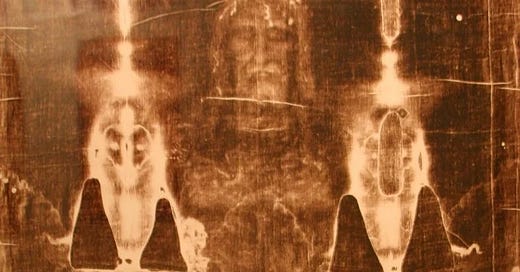The Shroud of Turin a Sacred Witness to Christ’s Suffering and Resurrection
A Sacred Relic That Bridges Faith and History
How do we know Christ suffered as the Gospels describe?
Can physical evidence deepen our faith in His resurrection?
For centuries, the Shroud of Turin has sparked awe, skepticism, and devotion, holding an extraordinary place in Christian history.
The Shroud’s Appearance and Connection to Christ
The Shroud of Turin is a linen cloth measuring about 14 feet long and 3.5 feet wide. It bears the faint image of a man who suffered horrific injuries consistent with crucifixion.
The wounds correspond to the biblical descriptions of Christ’s Passion: a pierced side, nail marks in the wrists and feet, and bloodstains matching a crown of thorns. These details compel believers to reflect on Isaiah’s prophecy: “He was pierced for our transgressions; He was crushed for our iniquities” (Isaiah 53:5).
Many Christians regard the Shroud as the burial cloth of Jesus, described in John 19:40: “Taking Jesus’ body, the two of them wrapped it, with the spices, in strips of linen.” Its connection to the resurrection is profound, as the Gospels state the cloth was found in the empty tomb (Luke 24:12).
The History of the Shroud of Turin
The Shroud’s early history is shrouded in mystery. Some traditions trace it to the Edessa Image, a miraculous imprint of Christ’s face linked to the ancient city of Edessa (modern-day Turkey).
By the 14th century, the Shroud appeared in Lirey, France, under the care of Geoffrey de Charny, a French knight. In 1578, it was moved to Turin, Italy, where it remains today in the custody of the Catholic Church.
Throughout its journey, the Shroud has survived fires, wars, and controversy. In 1532, a church fire scorched the cloth, leaving burn marks and water stains, yet the image of the man remained intact—a testament to its resilience.
Scientific Studies and the Debate Over Authenticity
The Shroud has undergone extensive scientific analysis, including radiocarbon dating, forensic examination, and microscopic studies. In 1988, radiocarbon tests dated the cloth to the Middle Ages, raising doubts about its authenticity.
However, critics argued that contamination from the 1532 fire or repair work might have skewed the results. Subsequent studies have cast doubt on the medieval dating, reigniting belief in its ancient origin.
Forensic experts have examined the wounds, bloodstains, and image details. The bloodstains match the rare AB blood type, common in ancient Middle Eastern populations.
Additionally, the image is not painted but appears as a superficial discoloration of the fibers, defying artistic explanation. “The life of the flesh is in the blood,” Leviticus 17:11 reminds us, underscoring the sacrificial nature of Christ’s suffering.
Confirmations of Its Authenticity by Believers and Experts
Despite skepticism, many prominent figures and scientists affirm the Shroud’s authenticity. Italian scientist Giulio Fanti used advanced spectroscopy to date the fibers to the 1st century AD. Pope Pius XII referred to the Shroud as “a mirror of the Gospel” and authorized its veneration. Other popes, including John Paul II and Francis, have described it as a sacred relic inspiring faith.
The Shroud’s message transcends empirical evidence. As John Paul II stated: “The Shroud is a challenge to the intelligence, and it requires every person, especially the researcher, to take it seriously.”
The Shroud’s Spiritual Significance for Believers
For Christians, the Shroud is more than a relic; it is a profound witness to Christ’s Passion and resurrection. Its bloodstains remind us of the price Jesus paid for humanity’s sins, fulfilling Hebrews 9:22: “Without the shedding of blood there is no forgiveness.” The image itself—faint, enigmatic, and enduring—parallels the mystery of faith.
Believers draw comfort and inspiration from the Shroud, seeing it as a tangible connection to Christ. It encourages deeper meditation on His suffering, as Paul wrote: “I have been crucified with Christ and I no longer live, but Christ lives in me” (Galatians 2:20).
Why the Shroud Matters to Christians Today
In a world increasingly skeptical of faith, the Shroud offers a powerful reminder of Christ’s sacrifice and the hope of resurrection. It serves as a bridge between history and spirituality, inviting both believers and skeptics to consider the reality of Jesus’ life, death, and resurrection.
As we ponder the Shroud, let us remember Jesus’ words to Thomas: “Because you have seen me, you have believed; blessed are those who have not seen and yet have believed” (John 20:29). Whether we view the Shroud as a relic or a symbol, it calls us to a deeper faith and greater devotion to the Gospel.
Parting Words
The Shroud of Turin remains a source of mystery and inspiration, challenging us to reflect on the central truths of Christianity.
It is a sacred artifact, a scientific puzzle, and, most importantly, a testament to the love and sacrifice of Jesus Christ.
As we contemplate its history and significance, let us renew our faith in the One who gave His life for us and rose again, offering eternal hope to all who believe. “For God so loved the world that He gave His one and only Son” (John 3:16).







Yes, there are comments, just none you would like to hear!
Twice You have deleted my comments. You are truly fearful of your lies being made manifest. The Witness of Christ is The Holy Scriptures. And Gods’ people who speak His holy Word. No ancient relic is any Witness of Christ. Take your shroud with you to your eternal home, you can use it to swat flames.